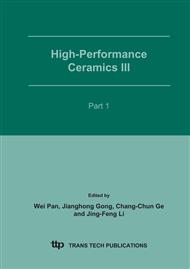[1]
Landolt-Bornstein: Numerical Data and functional relationships in science and technology, New Series, Group III, Vol. 16, Ferroelectric and Related substances, Subvolume A: Oxides; p.75, (1969).
Google Scholar
[2]
A. Outzourhit, J. U. Trefny, T. Kito, B. Yarar, A. Naziripour and A. M. Hermann: Thin Solid Films, Vol. 259 (1995), p.218.
DOI: 10.1016/0040-6090(94)06451-2
Google Scholar
[3]
C. Basceri, S. K. Streiffer, A. I. Kingon and R. Waser: J. Appl. Phys. Vol. 82 (1997), p.2497.
Google Scholar
[4]
P. Padmini, T. R. Taylor, M. J. Lefevre, A. S. Nagra, R. A. York and J. S. Speck: Appl. Phys. Lett. Vol. 75 (1999), p.3186.
Google Scholar
[5]
C. L. Chen, H. H. Feng, Z. Zhang, A. Brazdeikis, Z. J. Huang, W. K. Chu, C. W. Chu, F. A. Miranda, F. W. Van Keuls, R. R. Romanofsky and Y. Liou: Appl. Phys. Lett. Vol. 75 (1999), p.412.
DOI: 10.1063/1.124392
Google Scholar
[6]
P. C. Joshi and M. W. Cole: Appl. Phys. Lett. Vol. 77 (2000), p.289.
Google Scholar
[7]
A.D. Li, C.Z. Ge, P. Lu, D. Wu, S.B. Xiong, and N.B. Ming: Appl. Phys. Lett. Vol. 70 (1997), p.1616.
Google Scholar
[8]
K. H. Yoon, J. H. Sohn, B. D. Lee and D. H. Kang: Appl. Phys. Lett. Vol. 81 (2002), p.5012.
Google Scholar
[9]
T. B. Wu, C. M. Wu and M. L. Chen: Appl. Phys. Lett. Vol. 69 (1996), p.3659.
Google Scholar
[10]
P. C. Joshi and M. W. Cole: Appl. Phys. Lett. Vol. 77 (2000), p.289.
Google Scholar
[11]
K. H. Ahn, S. Baik, and S. S. Kim: J. Appl. Phys. Vol. 92 (2002), p.265.
Google Scholar
[12]
S. G. Lu, X. H. Zhu, C. L. Mak, K. H. Wong, H. L. W. Chan, and C. L. Choy: Appl. Phys. Lett. Vol. 82 (2003), p.2877.
Google Scholar
[13]
C. Hubert and J. Levy: Appl. Phys. Lett. Vol. 73 (1998), p.3229.
Google Scholar
[14]
T. Noma, S. Wada, M. Yano and T. Suzuki: J. Appl. Phys. Vol. 80 (1996), p.5223.
Google Scholar
[15]
T. P. C. Juan, S. M. Chen and J. Y. M. Lee: J. Appl. Phys. Vol. 95 (2004), p.3120.
Google Scholar
[16]
J. F. Scott: Ferroelectric Rev. Vol. 1 (1998).
Google Scholar


